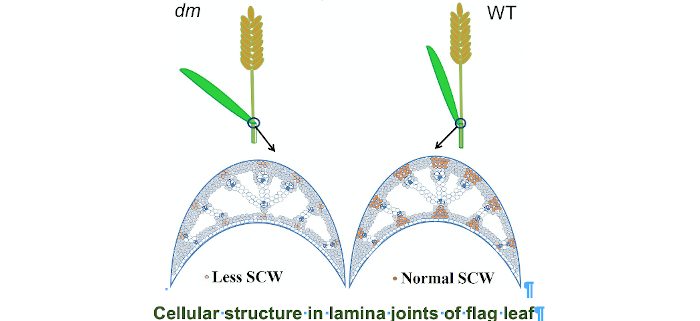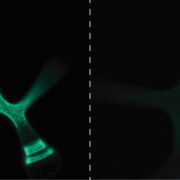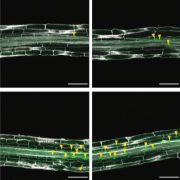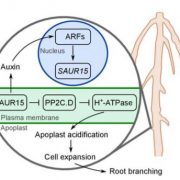A role for auxin in flag leaf angle in rice
Guoqiang Huang
Joint International Research Laboratory of Metabolic & Developmental Sciences, State Key Laboratory of Hybrid Rice, SJTU-University of Adelaide Joint Centre for Agriculture and Health, School of Life Sciences and Biotechnology, Shanghai Jiao Tong University, Shanghai, China
Background: The flag leaf is the top leaf on a rice stem, closest to the grain-producing panicle. Flag leaves have a major role in providing energy to the developing grain, and any impact on photosynthesis in the flag leaf can have a dramatic effect on grain productivity. In a rice field, overall yield per area depends on maximizing plant density, so crop lines with erect flag leaves are preferred; these plants can be planted more closely together without compromising grain yield per plant. The angle of the flag leaf to the main stem is primarily determined by the shape and structure of the lamina joint, which connects the flag leaf to the stem. The cellular organization in the lamina joint maintains flag leaf erectness, so appropriate cell elongation on both sides of the joint, the development of mechanical tissues, and cell wall composition, all impact flag leaf angle.
Question: We wanted to know whether and how auxin, a plant hormone known to be involved in a range of developmental pathways, may modulate flag leaf angle in rice. We investigated this mainly by looking at the expression of auxin-responsive factors, OsARF6 and OsARF17.
Findings: We found that both OsARF6 and OsARF17 genes were highly expressed in flag leaf lamina joints. Knockout mutants that lacked functional OsARF6 and OsARF17 exhibited larger flag leaf angles, and were found to have abnormal secondary cell walls. Yield was decreased in the knockout mutants in densely planted conditions. We identified a third gene, ILA1, that directs secondary cell wall biosynthesis in rice, whose expression was directly activated by OsARF6 and OsARF17 independently and synergistically, revealing one pathway that controls flag leaf angle.
Next steps: Fine-tuning this auxin signaling pathway can provide better control of flag leaf angles in elite rice cultivars, allowing for greater planting densities and therefore higher yield. Understanding this new pathway provides promising new targets for rice breeders and further research in the future.
Guoqiang Huang, Heng Hu, Allison van de Meene, Jiao Zhang, Le Dong, Shuai Zheng, Fengli Zhang, Natalie S. Betts, Wanqi Liang, Malcolm J. Bennett, Staffan Persson, Dabing Zhang. (2021). AUXIN RESPONSE FACTOR 6 and 7 control the flag leaf angle in rice by regulating secondary cell wall biosynthesis of lamina joints. Plant Cell. https://doi.org/10.1093/plcell/koab175










